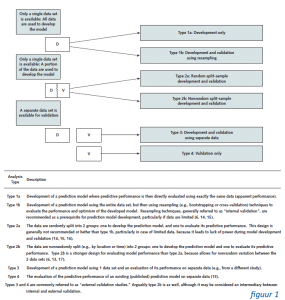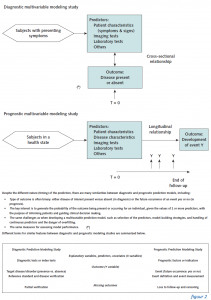The TRIPOD+AI Statement is a 27-item checklist, which aims to improve the reporting of studies developing, validating, or extending (updating) of a prediction model, whether for diagnostic, prognostic, monitoring or screening purposes, irrespective of the medical domain, the data-analytical technique used, the outcome predicted or the predictors being used. TRIPOD+AI is an extension and update of the original TRIPOD-2015: TRIPOD+AI replaces TRIPOD-2015.
What is a prediction model?
A prediction model is a mathematical equation that combines information from multiple predictors or input features observed or measured from an individual to predict the probability of the presence (diagnosis) or future occurrence (prognosis) of a particular outcome. Other names include risk prediction model, prediction algorithm, predictive model, prediction rule, and risk score.
Diagnostic and prognostic prediction models
In medicine, prediction models fall into 2 broad categories: diagnostic and prognostic prediction models, which encompass prediction models used for screening or prediction purposes in the general population, as well as disease or therapy response monitoring models. In TRIPOD+AI we collectively refer to diagnostic and prognostic prediction models as “prediction models”.
Diagnostic models estimate the probability that a certain condition or disease is present or absent at the moment of prediction, e.g. to inform the referral of patients for further testing, to initiate treatment directly, or to reassure patients that a serious cause for their symptoms is unlikely. Prognostic models estimate the probability of a particular outcome or event (e.g. mortality, disease occurrence or recurrence, complication) within in a certain period (e.g. hours, days, weeks, or years) in the future, e.g. for planning lifestyle or therapeutic decisions or to risk-stratify participants in therapeutic intervention trials. The main differences between a diagnostic and prognostic prediction model is the concept of time.
Development, validation, updating of a prediction model
 Prediction model studies may address the development of a new prediction model, the evaluation of the predictive performance or accuracy of a previously developed model in other data sets (often referred to as external model validation), the improvement or updating of a previously developed model, or a combination of these.
Prediction model studies may address the development of a new prediction model, the evaluation of the predictive performance or accuracy of a previously developed model in other data sets (often referred to as external model validation), the improvement or updating of a previously developed model, or a combination of these.
Studies may, for example, seek to update an existing prediction model by quantifying the incremental value of addition of a specific predictor, by recalibrating the so-called baseline risk or hazard, by adding an entirely new predictor to the existing model or, or by completely refitting the existing model in the validation data at hand.


